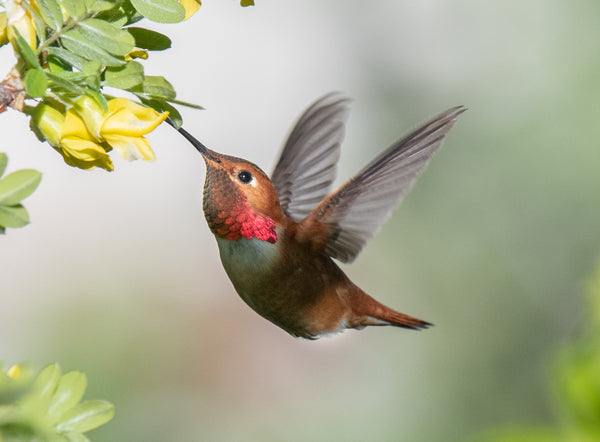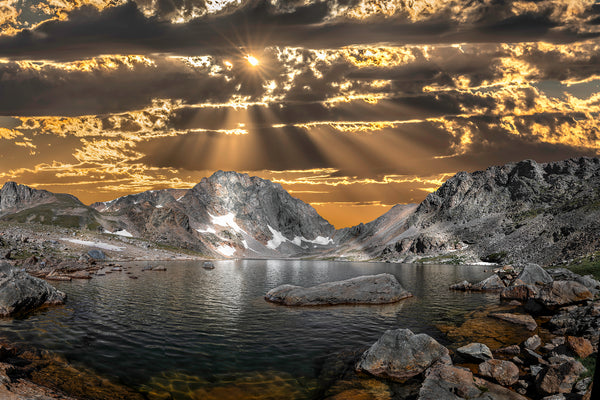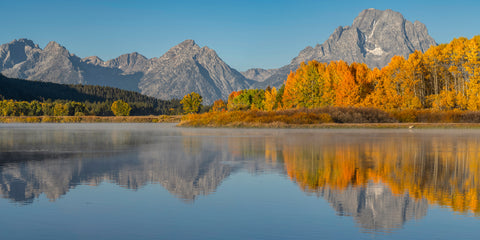On my June 13 birthday this summer, it snowed in the mountains of Southwest Montana. It was winter’s last volley, fired blindly into the Rockies, striking the Madison but not the Bridgers, falling on the tallest peaks of the Absaroka Beartooth but missing the Gallatin.
What in the hell has happened since, I ask myself this morning as I look out at an unseasonably-warm November day? My giant, Russian sunflowers lie shattered and brown when it seems only moments ago I rejoiced at the sight of their oblong leaves poking from the soil. They grew to eleven feet this year, a memory that feels more distant than that final birthday snow. A pine squirrel struggles over one of their heads, forsaking its seeds for the large spruce cone jutting from both sides of its mouth. He’s been as busy hauling them this morning as the flock of starlings I can see has been stripping the few frost-withered chokecherries remaining on a neighbor’s tree. They, like I, sense that this will be one of the final days of fall. Maybe the last time summer will prevail in a skirmish with her colder sister.
Tomorrow, after a Canadian cold front has dusted our mountains with snow, I may hunt elk deep in the wilderness that beckons. But today, while the world outside holds warmth that I hope helps me remember, I want to revisit summer.
*
I start with a June trip to Utah where I spent a few days wandering the desert, exploring the twisting, narrow canyons cut down through sandstone during thousands of years of violent runoff from flash floods. I ran my hands over the smooth, red rock there, bisected by layers of hardened, volcanic ash bearing tracks of dinosaurs, imagining their footfalls here when this land was not yet desert. I looked at one of my own tracks, a boot print in rusty mud, wondering what some creature might think of it in another hundred million years? Wondering if our kind will be as foreign to it as the great, Jurassic lizards are to me? This morning, that trip and the Milky Way image that I captured over Castle Valley, the lone columbine I found flowering in deep shade at the head of a slot canyon, and the stormy sunset that I watched wash away day in Arches National Park feel as far off as the deep tracks of the adult allosaurus that I saw.

Next to a day in Montana’s Pryor Mountains, similar in many ways to Utah. I spent a morning waking the foothills, zigzagging in and out of squat junipers, chasing tropical-looking juniper hairstreak butterflies whose fresh wings eluded me more times than not. By noon, I’d been made a fool of enough by them and hiked higher into forests of Douglas fir and then alpine meadows where drifts of snow persisted. Elevation-stunted lupines were beginning to bloom, kissing the land with hues of blue that stretched to the horizon, though the wind was cold and most other flowers were not yet swelling buds. At the base of a limestone ridge, I surprised a fox, its winter fur hanging from it like unspun wool. We stared at each other for a moment, but when I lifted my camera it was gone in a graceful leap so incongruous with its ratty appearance that I laughed out loud.
On to what has become an annual pilgrimage to Pine Creek Lake in the Absaroka Beartooth Range above the Yellowstone River, this time with 60 pounds of astrophotography gear, a small tent, and an uneasy recognition that the hike is more difficult than it was a year earlier. I spent an afternoon plodding uphill through burned timber where I once photographed a sea of glacier lilies, past rockslides where hoary marmots whistled their derision or encouragement – I hope the latter – and along streams swollen from the height of mountain snowmelt.I spent two nights on the granite shores of the lake, watching the last vestige of ice melt off during the day and the Milky Way so bright at night that it cast a shadow. Wondrous, green air-glow danced over the eastern horizon while small moths drew near my headlamp and the night smelled of spruce embers glowing in my fire ring. I remember thinking how odd it was that, when daylight stretched longer than at any other time of year, I had sought out this place to photograph the night.
Next to birds in my backyard. Mountain residents stopping in an urban environment for suet hung in a plum tree and sugar water suspended in a hummingbird feeder. During their brief stay, I photographed a parakeet-like western tanager, a male calliope hummingbird during a rain shower, and its larger cousin, a rufous hummingbird, that preferred locust blossoms to my synthetic nectar. The first day that I felt a quickened pulse, one recognizing the speed of changing seasons, was the first day they didn’t appear at my feeders.



I had to wait five years for perfect conditions in Wyoming’s Big Horn Mountains to capture my favorite image of the summer, the great, celestial heavens over a meadow bursting with flowers. It’s a field I travel to each July, losing track of time while I watch myriad pollinators feverishly visiting tens of thousands of blossoms. This year, after photographing fritillaries, tiger swallowtails, ruddy coppers, and half a dozen other varieties of butterflies, I climbed into a pitchy fir and positioned four headlamps, their lenses covered with wax paper to diffuse their beams. In the final moments of twilight, I aimed them out into the meadow before me and spent a magical couple of hours photographing the scene at night with Jupiter and Saturn appearing between the dark silhouettes of conifers. When I was finished, I lay down on a cot in a sea of flowers that, in the early-morning mist, smelled like the honey I use in winter coffee, another recognition that seasons move fast and in one direction.
Back in Montana, the wildflowers in the Gravelly Range, while perhaps not as prolific, were no less beautiful. Camping again, I rose in the hours before dawn to shoot Venus, the morning star, over red paintbrush. Though my eyes couldn’t tell yet, the sun was rushing close enough to the horizon to give a gentle glow there and impart a blue feel to the entire image, much like the color of distant, blooming lupines in the Pryors.
I was rewarded for my most strenuous hike of the summer by this image of the Milky Way over Beehive Lake in Montana’s Lee Metcalf Wilderness. After a steady, three-and-a-half mile climb, I dropped down snow-packed avalanche chutes and steep, scree slides to the shoreline, balancing a very heavy pack, my arms burning from trying to distribute my weight onto the trekking poles that I gripped.
I was there at the apex of summer and the very height of the mosquito season. They were unrelenting, feasting on any exposed skin, happy to see how much blood they could extract from my eyebrows. Without a tent this time, I used an oversized garbage bag as a poncho, retreating into it after my shoot, half sleeping for a few hours with my back against a granite, lakeside boulder covered in freshly-hatched moths.
Summer in the Rockies can end during a single cold front, and the cool, north wind spoke to that potential on the day that I hiked into the east side of the Absaroka Range. I took camera gear and a telescoping spinning rod to Moon Lake, where I caught a few hardy cutthroat and was treated to a spectacular show of afternoon sun and clouds. In the early evening, as I retraced my steps to my truck, a curious weasel took a break from hunting pika to play peekaboo with me.

I missed the peak of fall color in Northern Vermont this year, arriving too late after a summer of drought that sped up the foliage season ten days. Still, the forest under the depleted canopy was lovely, and I enjoyed spending time in my natal state. I came away with a macro shot of dew clinging to the silk-like strands of a milkweed seed, a shot of one of my favorite backroads flanked by morning mist, and a photograph of the deep woods where white birch seem to glow.
And now, fall is nearly over in Montana, and I want to spend this warm afternoon soaking up the sun’s heat so that I may draw on it a few months from now when all these memories will seem more distant. I want to walk somewhere out of the wind and touch the grass and the Earth. Caress it goodbye until some day in mid-April that I hope finds me wondering where winter went as much as I now wonder, despite these reminiscences, what became of summer.

**Many of the photos accompanying this blog are available for purchase. The ones for sale are links, and clicking on the picture will take you to their page where more information, including sizes and prices, can be found**
















Brian Knipping
you simply amaze me at everything you do. its an honor to know you my friend.
Justin French
Soul quenching! This is the next-best thing to taking the trip with you! What a journey. Well done – Thanks for doing what you do!
Liz
I always enjoy reading about the journey that goes with the photos. Thank you for bringing us all along.
Rosy Parsons
Thanks for your sacrifice, endurance, and devotion to capturing exquisite images of remote, wild spaces and their precious inhabitants. So touching. Your sense of seeking and of adventure is unmatched. The more I gaze at these pictures, the natural glow seems to multiply exponentially, providing solace through tough times. As usual, you nail it.
Jan Leyburn
Your photos are becoming increasingly magical and wondrous.